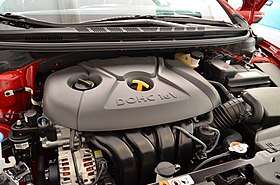Hyundai Nu engine
The Hyundai Nu engine was introduced in the 2011 Hyundai Elantra to replace the previous Beta engines. It was designed to fill the gap between the new Gamma 1.6L and the 2.0L Theta II.
| Ν-engine | |
|---|---|
 | |
| Overview | |
| Manufacturer | Hyundai Motor Company |
| Production | 2010-present |
| Layout | |
| Configuration | Inline-four |
| Displacement | 1.8 L; 109.7 cu in (1,797 cc) 2.0 L (1,999 cc) |
| Block material | Aluminium |
| Head material | Aluminium |
| Valvetrain | DOHC 16V D-CVVT |
| Compression ratio | 1.8 L 10.3:1 2.0 L MPI 10.3:1 2.0 L GDI 11.5:1 |
| RPM range | |
| Redline | 6800 rpm |
| Combustion | |
| Fuel system | MPI, GDI |
| Fuel type | Unleaded gasoline |
| Oil system | Pressure feed |
| Cooling system | Water-cooled |
| Output | |
| Power output | 1.8 L 148 hp (110 kW) at 6500 rpm 2.0 L MPI 164 hp (122 kW) at 6500 rpm 2.0 L GDI 174 hp (130 kW) at 6500 rpm |
| Torque output | 1.8 L 131 lb⋅ft (178 N⋅m) at 4700 rpm 2.0 L MPI 148 lb⋅ft (201 N⋅m) at 4800 rpm 2.0 L GDI 157 lb⋅ft (213 N⋅m) at 4700 rpm |
| Chronology | |
| Predecessor | Beta |
Nu MPi
1.8L
The 1.8 L (1,797 cc) Nu features a bore x stroke of 81 mm × 87.12 mm (3.19 in × 3.43 in). This engine features[1] MPI, and Dual-Continuous Variable Valve Timing aka D-CVVT pushing power output to 150 PS (110 kW; 148 hp) at 6,500 rpm with 18.1 kg⋅m (131 lb⋅ft; 178 N⋅m) of torque at 4,700 rpm.[2]
Hyundai Nu engine Specification:
- Displacement: 1.8 L (1,797 cc)
- Bore x stroke of 81 mm × 87.12 mm (3.19 in × 3.43 in) (offset crank to cylinder bore)
- Compression ratio 10.3:1
- Power: 150 PS (110 kW; 148 hp) @ 6500 rpm
- Torque: 18.1 kg⋅m (131 lb⋅ft; 178 N⋅m) @ 4700 rpm
- Redline 6800 rpm
- Combustion Fuel system: MPI
- Valvetrain: Chain driven roller DOHC 16V D-CVVT
- Cylinder block & head: Aluminum
- Intake: Valve controlled Variable Induction System
Applications
- 2011–2016 Hyundai Elantra
- 2011–2017 Hyundai i30
- 2013–2016 Kia Forte LX
- 2014–present Hyundai Mistra
2.0L
The Nu 2.0 L (1,999 cc) version of this engine features the same 81 mm (3.19 in) bore but with a longer stroke of 97 mm (3.8 in) that produces 166 PS (122 kW; 164 hp) @ 6,500 rpm and 20.5 kg⋅m (148 lb⋅ft; 201 N⋅m) at 4,800 rpm.
Applications
- 2014–2020 Hyundai Elantra
- 2012–2019 Kia Soul
- 2012–present Hyundai i40
- 2013–2019 Kia Forte
- 2014–present Kia Sportage
- 2014–present Hyundai Mistra
- 2014–present Kia Optima
- 2014–present Hyundai Sonata
- 2016–present Hyundai Creta
- 2019–present Kia Seltos
2.0L Atkinson Cycle
The Atkinson Cycle version of the Nu MPi 2.0L was first released for the 2017 Hyundai Elantra and it produces 149–156 PS (110–115 kW; 147–154 hp) @ 6,200 rpm with 19.9 kg⋅m (144 lb⋅ft; 195 N⋅m) of torque at 4,500 rpm.
The engine promises improved fuel economy vs the normal 2.0L MPi and better thermal efficiency.
Applications
- 2017–present Hyundai Elantra
- 2018–present Hyundai Kona
- 2015–present Hyundai Tucson
- 2019–present Hyundai Veloster
- 2017-present Kia Forte
- 2020–present Kia Soul
- 2020–present Kia Seltos
Nu GDi
2.0L
The Nu GDi 2.0 L (1,999 cc) version of this engine features the same 81 mm (3.19 in) bore but with a longer stroke of 97 mm (3.82 in) that produces 176 PS (129 kW; 174 hp) at 6,500 rpm with 21.7 kg⋅m (157 lb⋅ft; 213 N⋅m) of torque at 4,700 rpm.
2.0L Hybrid
The Nu GDi Hybrid version of this engine combines a 2.0L engine with an electric motor and a 1.76KWh battery, the petrol engine makes 156 PS (115 kW; 154 hp) at 6,000 rpm with 19.3 kg⋅m (140 lb⋅ft; 189 N⋅m) of torque at 5,000 rpm while the electric motor makes 52 PS (38 kW; 51 hp) with 20.9 kg⋅m (151 lb⋅ft; 205 N⋅m) of torque for a combined power rating of 205 PS (151 kW; 202 hp).
Applications
- 2014–2016 Hyundai Elantra
- 2012–2019 Kia Soul
- 2013–present Kia Carens
- 2012–present Hyundai i40
- 2014–2018 Kia Forte EX
- 2014–present Hyundai Mistra
- 2016–present Kia Sportage
- 2016–present Kia Optima
- 2016–present Hyundai Sonata Hybrid
- 2017–present Hyundai i30
- 2019–present Hyundai Tucson
Nu LPi
2.0L
It is a hybrid variant with liquefied petroleum gas engine and electric motor.
It was used in Kia Optima LPI hybrid (DL3)
See also
References
- "2012 Hyundai Elantra Limited with 1.8L I4 Engine ~ Automobile Reviews". Autostills.blogspot.com. 2011-06-28. Retrieved 2012-05-10.
- "Specifications - 2012 Hyundai Elantra Limited - Yahoo! Autos". Autos.yahoo.com. Retrieved 2012-05-10.
Nu Engine in the LF Hyundai Sonata Hybrid http://www.hyundainews.com/us/en/models/sonata-hybrid/2017